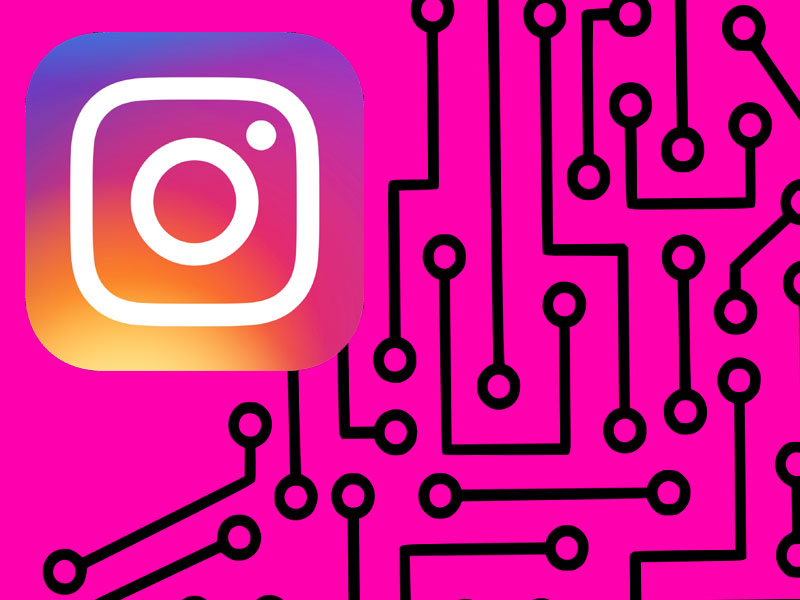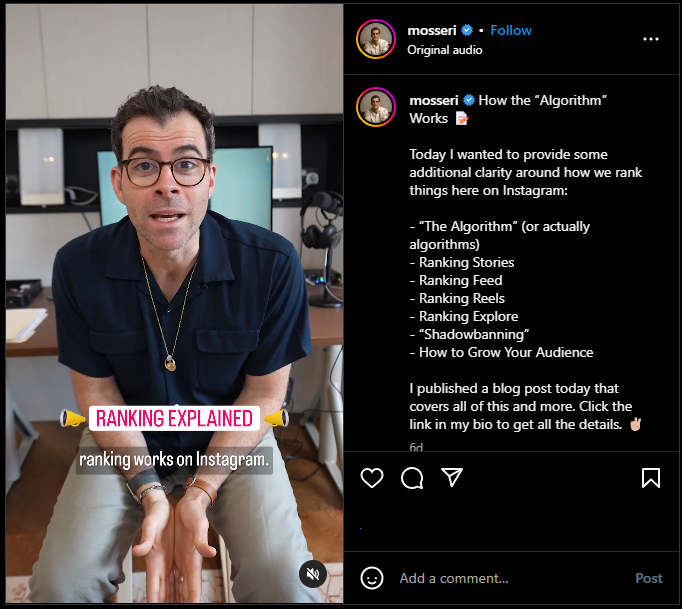
Do you ever wonder how Instagram decides what to show you? In a rare hint of transparency, Adam Mosseri, the big boss of Instagram, explained how the app's magic works and how you can have some control over it.

The Instagram Quarter
In the video posted on Instagram, he explains that the app has four main sections: the main feed, stories, the explore page, and reels.
- The Main Feed is where you see posts from the accounts you follow, such as your friends, family, celebrities, or brands. You will also see ads that are supposed to be relevant to your interests.
- Stories are short videos or photos that disappear after 24 hours. You can see stories from the accounts you follow at the top of your main feed or by tapping on their profile picture. You can also make your own stories and add stickers, filters, music, or polls.
- The Explore Page is where you can find new content that you might like, based on what you have liked, saved, or commented on before. You can also browse different topics or categories, such as fashion, sports, or art.
- Reels are short videos that are usually fun, creative, or entertaining. You can see reels from popular or emerging creators on the reels tab or on the explore page. You can also make your own reels and add music, effects, or text.
So Tell Me About the Algorithm
First the bad news. Adam explains that there is no single 'algorithm' as such, Instagram uses a bunch of signals to rank the posts you see on each part of the app. These signals are based on your activity, history, preferences, and interests. Some of the signals are:
- Content Details
This includes things like the time of day it was posted, how long it is, what location or hashtags it has, and how popular it has become.
- Information about the account
This includes things like how many followers they have, how often they post, what kind of stuff they make, and how closely they are related to you.
- Your activity
This includes things like how often you use Instagram, how long you spend on each part of the app, what accounts you interact with, what stuff you like, save, or comment on, and what feedback you give.
- Your history
This includes things like how long you have been using Instagram, what accounts you have followed or unfollowed in the past, what stuff you have hidden or muted before, and what topics or categories you have shown interest in.
Taking the above into account, Instagram uses these signals to guess how likely you are to want to see a certain post and rank it accordingly. However, different parts of the app have different goals and priorities. For example:
- The Main Feed tries to show you content from your close friends and family first, as well as adding in posts that are timely and it thinks are relevant to your interests.
- Stories show you content from your best friends first, as well as ones that are fresh and engaging.
- The Explore page tries to show you stuff that is diverse and personalized to your tastes, as well as posts that are trending or viral.
- And lastly, Reels tries to show you clips that are entertaining and original, as well as content that showcases new talent or perspectives.
How Can You Influence What You See?
He claims that you have some control over what you see on Instagram. You can influence the app's recommendations by following or unfollowing accounts (something in my opinion that we don't do enough, if you always scroll past someone you're following then unfollow them to stop them from influencing what you see, purge that list every so often).
Muting or hiding posts or stories will tell Instagram that you're not interested in this for the moment and conversely, saving or sharing posts that you like will tell Instagram that you want to see more of this stuff.
Another often overlooked feature of Instagram is the feedback feature. You can give feedback by tapping on the three dots icon and choosing "not interested". You can also report contact that you think violates Instagram's community guidelines by choosing "report". Feedback is a solid way to tell Instagram what you like and don't like, otherwise, it is just guessing based on how you interact with different posts.
Have We Learned Anything
I think it's great that the CEO of Instagram has published this video, it makes the platform feel a lot more "human" especially when compared with Facebook or TikTok which are completely closed books, but the information he gave was very top level, anybody working in Digital Marketing, Social Media Marketing or a power user of Instagram would already know this.
However, he has promised to publish more detailed information on the company blog over the coming weeks. This might provide some hidden gems, not only to help a user see more of what they actually want but also for social media marketers to leverage the best out of their content to get it in front of more eyes... I for one will certainly keep an eye out for his future blog posts.
Hey, I really could do with your help! If you find this article interesting, could you please do me a favour by either sharing it on your site or on social media. I would love to hear yours and other peoples' thoughts on this subject. And if this or any other content on the site has helped you and you would like to show your appreciation, then you can always
buy me a coffee ☕️ It would make the time I put into this more than worthwhile! Thank you 😃


